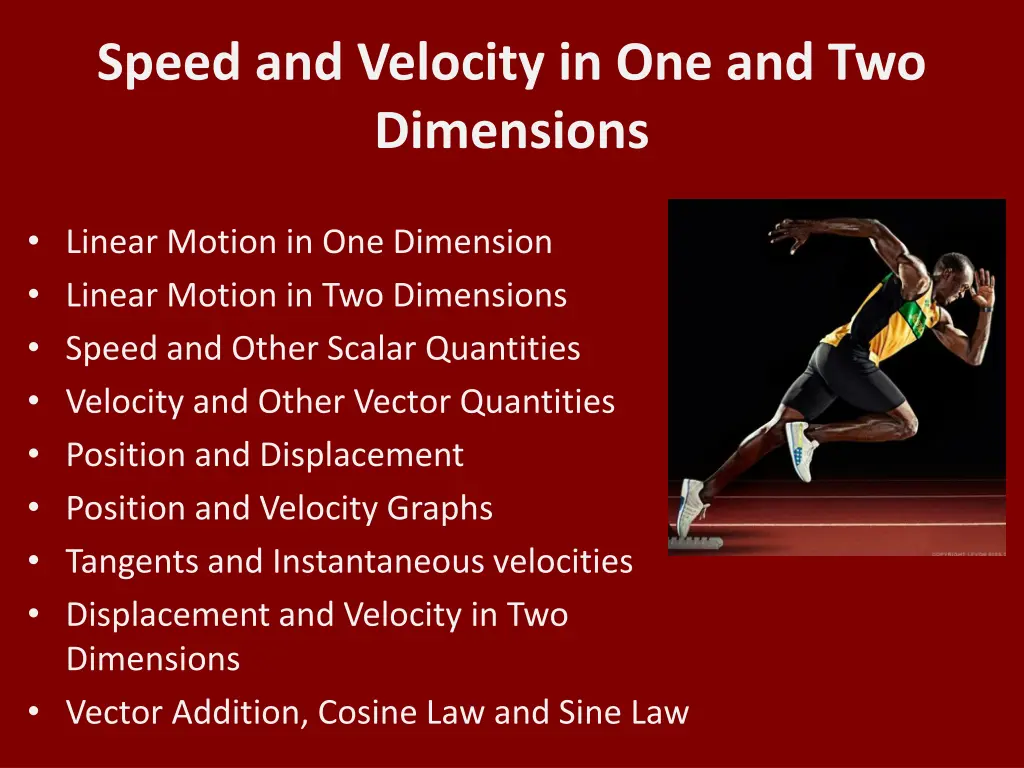
Understanding Speed and Velocity in Linear Motion
Dive into the fundamentals of speed and velocity in linear motion, covering topics like one-dimensional and two-dimensional motion, scalar and vector quantities, position, displacement, and more. Explore the concepts through informative slides and examples.
Download Presentation

Please find below an Image/Link to download the presentation.
The content on the website is provided AS IS for your information and personal use only. It may not be sold, licensed, or shared on other websites without obtaining consent from the author. If you encounter any issues during the download, it is possible that the publisher has removed the file from their server.
You are allowed to download the files provided on this website for personal or commercial use, subject to the condition that they are used lawfully. All files are the property of their respective owners.
The content on the website is provided AS IS for your information and personal use only. It may not be sold, licensed, or shared on other websites without obtaining consent from the author.
E N D
Presentation Transcript
Speed and Velocity in One and Two Dimensions Linear Motion in One Dimension Linear Motion in Two Dimensions Speed and Other Scalar Quantities Velocity and Other Vector Quantities Position and Displacement Position and Velocity Graphs Tangents and Instantaneous velocities Displacement and Velocity in Two Dimensions Vector Addition, Cosine Law and Sine Law
TeachWithFergy Preview File If you decide to purchase and the lesson isn't exactly what you need or thought it was, I will refund you 100% via PayPal. - Some slides appear blank because they have been removed. - Other slides may have ........... on them, this represents writing that has been removed. - Please note that the Entire Unit Package can also be purchased at a steep discount from my Store.
Kinematics The study of motion
Linear Motion in One Dimension ______________ E.g. Motion of a train along a straight line An object, like a ball, falling freely, vertically under gravity The vertical up and down oscillations of an object suspended from a vertical spring.
Check Your Understanding Ensure SI Units 1. What is the average speed of a cheetah that sprints 100 meters in 4 seconds? 2. If a . 1. If your .
Velocity and Other Vector Quantities In slideshow mode, click the image on the left to see how videos are embedded into the lesson A vector quantity is a quantity with a magnitude and direction. I.e. Displacement, and velocity I.e. 20 km/h [E]
Position and Displacement _____________ Displacement is how far an object is from its starting point Final position starting position
Velocity _____________ _____________ Change of position divided by the time interval for that change
Check Your Understanding A cyclist takes 25.1 s to cover the displacement of 115 m [E] from d1 to d2. (a) Calculate the cyclist s average velocity. (b) If the cyclist maintains the same average velocity for 1.00 h, what is the total displacement? (c) If the .
Think About It 1. Is it possible for the total distance travelled to equal the magnitude of the displacement? If no, why not? If yes, give an example. Is it possible . Is it possible for the magnitude of the displacement to exceed the total distance travelled? If no, why not? If yes, give an example. Can the average . A truck driver, reacting quickly to an emergency, applies the brakes. During the driver s 0.32 s reaction time, the truck maintains a constant velocity of 27 m/s [fwd]. What is the displacement of the truck during the time the driver takes to react? 2. 3. 4. 5.
Position and Velocity Graphs Uniform Motion For a constant velocity motion (the same velocity is maintained), the position-time graph is a straight line and the velocity-time graph is horizontal. Position-Time Data Position-Time & Velocity-Time Graphs
Check Your Understanding Describe .
Check Your Understanding This is the position-time graph for a golf ball rolling along a straight trough which slopes downward from east to west. (a) Describe .. (b) Calculate the instantaneous velocity at t = 3.0s. (c) Determine . Picture has been removed
Vector Addition, Cosine Law and Sine Law _____________ a b c Sine Law: = = sin sin sin A B C Vector Component Addition: Determine all the sum of the x and y components, create a right triangle and solve the hypotenuse using the Pythagorean Theorem
Check Your Understanding In 4.4 s, a chickadee flies in a horizontal plane from a fence post (P) to a bush (B) and then to a bird feeder (F), as shown below. Find the following: (a)total distance travelled (b)average . (c) total displacement (d)average velocity
Homework 1. Determine the vector sum of the displacements d1 = 2.4 m [32 S of W]; d2 = 1.6 m [S]; and d3 = 4.9 m [27 S of E]. 2. A skater on Ottawa s Rideau Canal travels in a straight line 8.5 x 102 m [25 N of E] and . (a) What is the skater s displacement? (b) What are the skater s averages peed and average velocity?






















